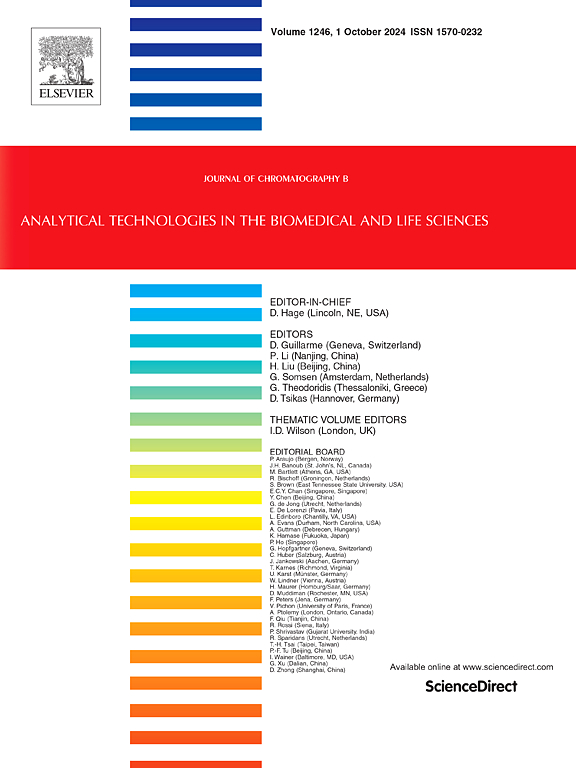尺寸排阻色谱法:从昆虫血淋巴中分离 hsEV 的有效工具
IF 2.8
3区 医学
Q2 BIOCHEMICAL RESEARCH METHODS
引用次数: 0
摘要
细胞外囊泡在生物系统中起着重要的作用,它们可以改变细胞的表型和功能。ev的发现导致了新型疫苗的开发,在疾病进展过程中具有免疫抑制和免疫刺激作用。为了解决电动汽车的机遇,这里我们使用昆虫作为模型系统。这种昆虫也有药用价值,因为它产生抗菌肽,这种肽在循环液体中被发现,称为血淋巴。血淋巴由防御素、gloverins、富含脯氨酸的多肽、攻击素、天蚕素、桑草素、阴离子抗菌肽和其他几种成分组成,这些成分可以形成强大的防御机制,抵御广泛的病原体。本研究利用昆虫血淋巴进行EV的分离,血淋巴包封了这类蛋白并作为货物转运体。由于生物成因不明,我们将其定义为血淋巴源性小细胞外囊泡(hsEV)。本文讨论了分离hsEV的适当方法。对血淋巴进行尺寸排除层析分离。利用抗cd63、抗flotilin -2、TEM、FESEM、共聚焦显微镜和DLS进行分子和物理表征。分离的hsEV通过测定细菌生长情况来评价其抗菌性能。本文章由计算机程序翻译,如有差异,请以英文原文为准。
Size exclusion chromatography: An efficient tool for hsEV isolation from insect Haemolymph
Extracellular vesicles (EV) serve an important role in biological system as they can change the phenotype and function of the cell. The discovery of EVs has led to the development of novel vaccines, associated with immunosuppressive and immunostimulatory effects during disease progression. To address the opportunities in EVs, here we used insect as model system. The insect also has medicinal properties as it produces antimicrobial peptides which are found circulating fluid called as hemolymph. Hemolymph consists of defensins, gloverins, proline-rich peptides, attacins, cecropins, moricins, anionic antimicrobial peptides, and several other components that create robust defense mechanisms against a broad spectrum of pathogens. Here, the insect hemolymph was used for EV isolation which encapsulates such kinds of proteins and acts as cargo transporters. As the biogenesis was unknown, we have defined it as hemolymph-derived small extracellular vesicles (hsEV). The present paper deals with the appropriate methodology for the isolation of hsEV. The hemolymph was processed for isolation via size exclusion chromatography. Molecular and physical characterization was performed using western blotting utilizing anti-CD63, anti-Flotillin-2, TEM, FESEM, confocal microscopy, and DLS. The isolated hsEV was used to assess the antibacterial property by measuring bacterial growth.
求助全文
通过发布文献求助,成功后即可免费获取论文全文。
去求助
来源期刊

Journal of Chromatography B
医学-分析化学
CiteScore
5.60
自引率
3.30%
发文量
306
审稿时长
44 days
期刊介绍:
The Journal of Chromatography B publishes papers on developments in separation science relevant to biology and biomedical research including both fundamental advances and applications. Analytical techniques which may be considered include the various facets of chromatography, electrophoresis and related methods, affinity and immunoaffinity-based methodologies, hyphenated and other multi-dimensional techniques, and microanalytical approaches. The journal also considers articles reporting developments in sample preparation, detection techniques including mass spectrometry, and data handling and analysis.
Developments related to preparative separations for the isolation and purification of components of biological systems may be published, including chromatographic and electrophoretic methods, affinity separations, field flow fractionation and other preparative approaches.
Applications to the analysis of biological systems and samples will be considered when the analytical science contains a significant element of novelty, e.g. a new approach to the separation of a compound, novel combination of analytical techniques, or significantly improved analytical performance.
 求助内容:
求助内容: 应助结果提醒方式:
应助结果提醒方式:


